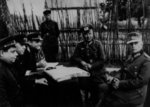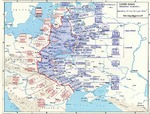Operation Bagration
Contributor: C. Peter Chen
ww2dbaseIn Apr 1944, Soviet leaders selected a plan to attack the German Group Center holding a bulge in Byelorussia and Ukraine. Knowing that to defeat such a concentration of German forces, the magnitude of Soviet preparations would alarm the German forces, therefore a deceptive operation was also planned to throw off the Germans. On 17 Apr the first deceptive tactic was employed to prepare for Bagration, which was to switch the entire Soviet front to a defensive mode by ceasing major offensives and to construct (sometimes false) defensive structures. Later, when the Soviet forces in the area could mean nothing but an assault, Soviet forces started to spread false intelligence that the offensive was to be made against Army Group South in Ukraine, reinforcing something that the German originally expected. When the operation launched, 1st and 3rd Ukrainian Armies in Ukraine were deployed to further support that misconception.
ww2dbaseThe Germans fell for the deceptions. In fact, the Germans interpreted the deceptive events in such depth that they actually made further maneuvers to make Army Group Center weaker; for instance, most armor in the German reserves were transferred to northern Ukraine, leaving Army Group Center in the north without proper reinforcements. Other factors such as the reaction to the western Allies' Normandy invasion also weakened the available forces on the Soviet front for the Germans.
ww2dbaseThe actual Bagration offensive began in the morning of 22 Jun 1944 with 1,700,000 Soviet troops and 6,000 armor rushing against 34 surprised German divisions, nearly achieving a 10-to-1 numerical advantage with armor and 7-to-1 with aircraft. The German lines fell apart quickly, and Minsk fell under Soviet control on 3 Jul, capturing 50,000 prisoners of war. Ten days later, Soviet troops reached the Polish border. By the end of Jul 1944, the entire Army Group Center ceased to exist, losing 300,000 men to death and 120,000 to capture. Over 2,000 tanks were lost as well. On the Soviet side, 60,000 were killed and nearly 3,000 tanks were lost. This was one of the very few major battles on the Soviet fronts where the Soviets suffered fewer casualties than the Germans. With Army Group Center completely wiped out, the German forces not only suffered a major defeat, but without Byelorussia the supply lines to Army Group North were also lost.
ww2dbaseOn 17 Jul, an offensive was launched against the German forces in Ukraine to leverage the victory in Byelorussia. This successful sister campaign to Bagration paved a way for Soviet troops to enter German-controlled Balkans. With the Soviet forces established in Ukraine, Romanians overthrew the dictator Ion Antonescu and switched sides to fight on the side of the Soviets. Across Romania's southern border, Bulgaria surrendered to Russia on 9 Sep, similarly declaring war on Germany upon its surrender.
ww2dbaseAfter WW2, Operation Bagration's deceptive operations became a model taught to Soviet Army cadets.
ww2dbaseSources: Global Security, Wikipedia.
Last Major Update: Oct 2005
Photographs
 |  |  |  |
Maps
 |
Operation Bagration Timeline
| 31 May 1944 | Stalin approved the plan for Operation Bagration, aimed at the destruction of German Armeegruppe Mitte. |
| 22 Jun 1944 | Soviet forces launched Operation Bagration, a major offensive against German forces in Byelorussia, with 1.2 million men, 31,000 heavy guns, 5,200 tanks, and 6,000 aircraft. The plan was to smash through Warsaw, Poland and East Prussia, Germanny to the Baltic coast; in doing so, they would trap German and Finnish forces in the north and isolate the German, Romanian, and Bulgarian armies in the south. |
| 24 Jun 1944 | Hitler ordered all but one division of LIII Korps, encircled near Vitebsk, Byelorussia, to break out. |
| 26 Jun 1944 | Red Army captured Vitebsk, Byelorussia. |
| 27 Jun 1944 | Soviet units captured Orsha, Byelorussia on the Dneiper River, while near Vitebsk German LIII Korps was finally destroyed. |
| 28 Jun 1944 | German 9.Armee became surrounded after Soviet forces captured Mogilev, Byelorussia and crossed the Berezina River. |
| 29 Jun 1944 | The 70,000 remaining troops of German Armeegruppe Mitte, surrounded near Bobruisk, Byelorussia, surrendered. |
| 1 Jul 1944 | 5th Guards Tank Army of the Soviet 3rd Byelorussian Front captured Borisov, Byelorussia. |
| 3 Jul 1944 | Soviet forces recaptured Minsk, Byelorussia, trapping over 100,000 Germans in the pocket. |
| 4 Jul 1944 | The Soviet 1st Baltic Front captured Polotsk, Byelorussia on its way towards Riga, Latvia, moving to cut off German Armeegruppe Nord as it retreated from Estonia. The Soviet troops were now roughly on the 1939 German-Soviet border. |
| 8 Jul 1944 | As Baranovichi, Byelorussia fell to the Soviets, German XII Corps surrendered its last 57,000 men. The German Armeegruppe Mitte alone had lost nearly 30 divisions in less than a month. |
| 9 Jul 1944 | Aiming to cut off German Armeegruppe Nord, Soviet 2nd Byelorussian Front attacked from Vitebsk, Byelorussia, Soviet 3rd Byelorussian Front attacked from Psovsk, and the Soviet Leningrad Front attacked toward Narva, Estonia. |
| 11 Jul 1944 | The last 35,000 men of German 4.Armee surrendered to Soviet troops at Minsk, Byelorussia. |
| 13 Jul 1944 | Red Army units captured Vilna, Lithuania. |
| 14 Jul 1944 | Pinsk, Byelorussia was captured by the Soviet forces. |
| 18 Jul 1944 | Soviet First Byelorussian Front launched a heavy attack across the Bug River aimed at Lublin in Poland, the Third Baltic Front attacked toward Pskov in Russia, while the First Ukraine Front advanced toward Lvov in Ukraine. |
| 21 Jul 1944 | The Soviet Third Baltic Front captured Ostrov, Pskov Oblast, Russia. |
| 22 Jul 1944 | In Ukraine, the Brody Pocket was eliminated; Soviet forces captured 17,000 German prisoners of war. To the north, Soviet units captured Panevezys, Lithuania. |
| 23 Jul 1944 | Soviet troops captured Pskov, Byelorussia. |
| 24 Jul 1944 | As Soviet units crossed the River San north of Lublin, Poland, German troops began evacuating that city. |
| 25 Jul 1944 | Soviet units reached the Vistula River in Poland. To the north, the Germans evacuated Narva, Estonia, taking up defensive positions to the west. |
| 26 Jul 1944 | Soviet forces captured Narva as they crossed the Estonian border. |
| 27 Jul 1944 | Bialystok in Poland, Dunaburg (Daugavpils) in Latvia, and Lviv in Ukraine were captured by Soviet forces; meanwhile, a major bridgehead was also established across the Vistula River near Magnuszew, Poland. |
| 28 Jul 1944 | Brest-Litovsk, Poland (now in Belarus), site of a joint German-Soviet victory parade in 1939, was captured by Soviet forces after heavy fighting. |
| 29 Jul 1944 | German Armeegruppe Nord was cut off as the Red Army reached the Baltic coast west of Riga, Latvia. |
| 30 Jul 1944 | The Soviet First Baltic Front reached Tukums, Latvia. |
| 1 Aug 1944 | Soviet forces captured Lithuania, cutting all roads between Germany and the Baltic States. |
| 2 Aug 1944 | The Soviet-sponsored 1st Polish Army established a bridgehead over the Vistula River south of Warsaw, Poland. |
| 3 Aug 1944 | The first Soviet attacks east of Warsaw, Poland were repulsed by the Germans. |
| 4 Aug 1944 | Soviet forces gained another bridgehead over the Vistula River in Poland near Baranov. |
| 6 Aug 1944 | The refinery city of Drohobyez, Poland was captured by the Red Army. |
| 14 Aug 1944 | Soviet forces launched an assault from their Vistula bridgeheads in Poland. |
| 17 Aug 1944 | Soviet troops reached the East Prussian border. |
| 18 Aug 1944 | Soviet forces captured Sandomierz, Poland. |
| 21 Aug 1944 | With Kriegsmarine support, the Germans opened a coastal corridor to German Armeegruppe Nord, but Hitler refused to authorize their withdrawal. |
| 25 Aug 1944 | Soviet 3rd Baltic Front captured Tartu, Estonia. |
| 14 Sep 1944 | Soviet First Baltic Front, Second Baltic Front, and Third Baltic Front launched a massive assault against German Armeegruppe Nord, pushing it back to Riga, Latvia. |
| 24 Sep 1944 | The STAVKA ordered the Soviet First Baltic Front to halt on the advance to Riga, Latvia, leaving the job to the Second Baltic Front and Third Baltic Front, and instead march toward Memel (now Klaipeda, Lithuania). |
| 5 Oct 1944 | Soviet First Baltic Front resumed the offensive toward Memel (now Klaipeda, Lithuania) to cut off German Armeegruppe Nord. |
| 10 Oct 1944 | Soviet units reached the Baltic coast at Memel (now Klaipeda, Lithuania), cutting off the 26 divisions of German Armeegruppe Nord once and for all. |
Você gostou deste artigo ou achou este artigo útil? Se sim, considere nos apoiar no Patreon. Qualquer valor já vai ajudar! Obrigado. Por favor, ajude-nos a divulgar o site: Fique atualizado com WW2DB: |
Visitor Submitted Comments
11 Sep 2015 10:53:06 PM
I think majority people in human society have tendency to compromise with social misgivings in peace time even at the cost of moral and remaining silent against unjust to them just for the sake of their short sited benefits. Ruling crook on such people takes full scale advantage to exploit them on the above tendency. War is an accumulated audit of human society where people of the nations compromised on their moral beyond a limit to the extent that prevailing socio economic formation might bear with. Even today, the same moral less selfishness is clearly visible in all the nations of the planet earth, when we see the problem of developing terrorism and selfish stand of different countries on terrorism. I do not find any difference in approach of all the countries of our world on terrorism and that of all countries exhibited their approach when Adolf Hitler (Nazi) was developing in Germany in past.
All visitor submitted comments are opinions of those making the submissions and do not reflect views of WW2DB.

» Bagramyan, Ivan
» Chuikov, Vasily
» Kuznetsov, Vasily
» Rokossovsky, Konstantin
» Rotmistrov, Pavel
» Shanina, Roza
» Vasilevsky, Aleksandr
» Zhukov, Georgy
Locations:
» Byelorussia
» Poland
» Ukraine
Related Book:
» Atlas of the Eastern Front 1941-45
- » 1,177 biografias
- » 337 eventos
- » 44,938 entradas na linha do tempo
- » 1,245 navios
- » 350 modelos de aeronaves
- » 207 modelos de veículos
- » 376 modelos de armas
- » 123 documentos históricos
- » 261 instalações
- » 470 eventos
- » 28,477 fotos
- » 365 mapas
George Patton, 31 May 1944
Por favor, considere nos apoiar no Patreon. Mesmo R$1 por mês já faz uma grande diferença. Obrigado!
Ou, por favor, nos apoie adquirindo alguns produtos do WW2DB na TeeSpring. Obrigado!
4 Nov 2014 05:17:26 PM
The casualties are utterly false. The russian lost roughly 100,000 men (wounded and killed). On the German side roughly 30,000 died. Even considering the many POWs on the German side, the Russians suffered more casualties. Only the Russian could compensate for the loss.